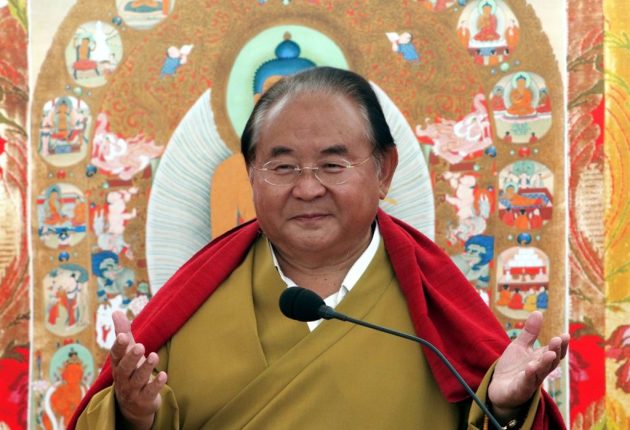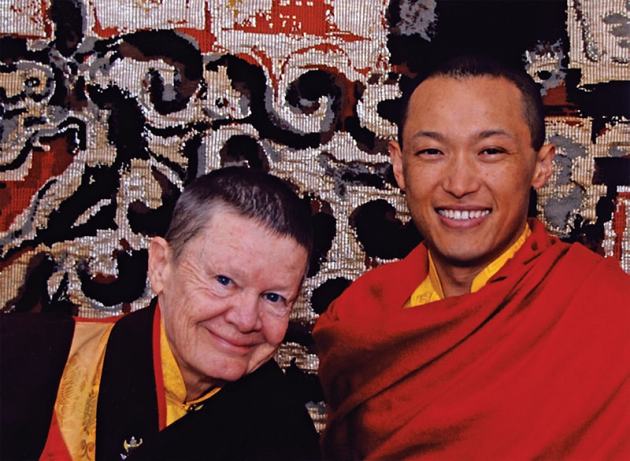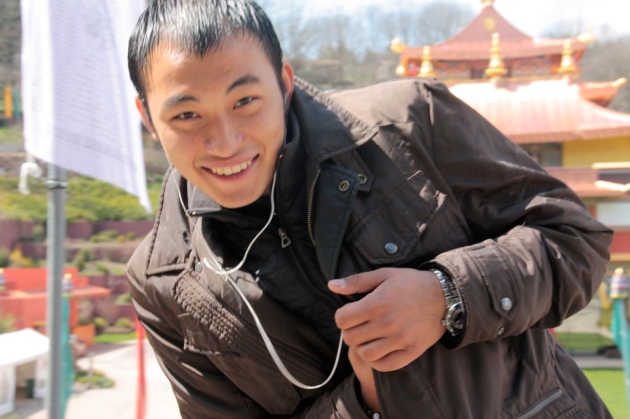Dharma’s Dark Side – Sexual Abuse & Tibetan Buddhist Leaders
Dharma’s Dark Side – Sexual Abuse & Tibetan Buddhist Leaders

Sogyal Rinpoche
On January 17, a headline in the Washington Post announced “Famed Buddhist nun Pema Chodron retires, cites handling of sexual misconduct allegations against her group’s leader.”
One of the best-known interpreters of Tibetan Buddhism in the West, Chodron is an influential teacher who has published a number of popular books including “When Things Fall Apart.” The group she publicly retired from is Shambhala, the global Buddhist and mindfulness organization founded by Chogyam Trungpa Rinpoche. Shambhala is one of the largest western Buddhist movements with more than 200 meditation centers around the world.
What follows is a summary of various web posts relating to abuse by various powerful male Buddhist teachers who have assaulted young female (and male) students, and used their powerful positions to maintain a code of silence which eventually cracked in line with the #MeToo movement.
Warning – it’s disturbing reading.
It is not uncommon for male teachers in various spiritual traditions to abuse their positions of power and prey on young devotees, often rationalizing somehow it aided their victim’s spiritual development. (At the Satyananda Yoga Ashram in New South Wales, Australia, victims were encouraged to believe that being raped by progressively more powerful men in the organization signified their increasing spiritual attainment)
From Krishna Pattahbi Jois (ashtanga yoga founder), Bikram Choudhury (bikram yoga founder), guru Asaram Bapu, and Swami Vivekananda Saraswati, to Swami Satyananda, Swami Nithyananda, Gurmeet Ram Rahim Singh (head of Dera Sacha Saud), and leaders in the Hare Krishna movement, all faced or have been convicted of serious abuse allegations.
In his book “Sex and the Spiritual Teacher,” Scott Edelstein writes: “The problem of spiritual teachers seducing or sexually abusing their students tarnishes every spiritual tradition, in seemingly every culture—and recorded cases go back many hundreds of years. These misdeeds damage the lives of women and men, children and adults, the rich and the poor, the foolish and the wise, the gullible and the discerning.”
The current crisis at Shambhala involves the community’s leader Sakyong Mipham Rinpoche, also known as Mr. Mukpo, who is the son of the late Trungpa Rinpoche. In late 2018, the Shambhala community learned that Sakyong Mipham Rinpoche had sexually assaulted numerous female students.

Pema Choldron & Sakyong Mipham Rinpoche
A series of reports published by the advocacy group Buddhist Project Sunshine accused Mipham of alleged sexual assault and child sex abuse — allegations Mipham and Shambhala International vehemently denied.
Six former attendants (known as Kusung) of Sakyong Mipham Rinpoche sent an open letter to Tricycle magazine last year detailing a pattern of physical, sexual, and psychological abuse.
“Often there is a theme of imploring us to believe that Mr. Mukpo’s behavior is beyond our understanding. We are asked to regard such activity as the guru’s method of waking us up. But, looking around the world, there’s nothing so prosaic as a leader using his power and position to take advantage of people under his care.
“He drank from sunset to sunrise, as he would behave in a provocative manner ranging from being gentle and vulnerable to being threatening and insecure. His behavior included demanding others to drink more and coercing some participants to take off their clothes.
“Mr. Mukpo was marching around and ordering each of them to do various things. Evidently he had demanded that everyone get completely naked, all but one woman halted this task at underwear. Some were crying and many appeared to be nervous.
“Mr. Mukpo began forcefully biting people, as he was known to do in the past. Those who likely consented to such assaults remarked to me that he had left bruises, which had been documented in photos.
“I asked every female Acharya (instructor) and Shastri (senior teacher) why there was such sexism. Almost as if trained in their responses, they all told me that in Vajrayana Buddhism male and female did not exist, therefore every day sexism was empty and if I practiced more I would see this. The general atmosphere in the court was one soaked in ancient patriarchy. Most of the men in leadership roles were either abusers themselves or witnessed it and silently endorsed it. I left because I knew unless something radical happened it would never change.
“Mr. Mukpo would invite me to his bedroom. Being a Kusung I went immediately to kneel at his side of the bed and waited for his question or command. I was surprised when instead he put his hand down my shirt and fondled my breasts and said, “please I just want to sleep,” firmly directing my head to his cock. I obliged and shook it off. I buried and minimized my own experiences for over 20 years.
“I watched hundreds of women go in and out of Mr. Mukpo’s bedroom. I held the hands of many. Rocked with them when they sobbed. Stayed with them when they just didn’t know what happened. Tried to warn them about what it feels like to be queen for a day. I saw one too many debauched nights and nursed one too many of the king’s hangovers. I feared for the women. I was disgusted by what I saw.
One woman who had suffered terrible sexual abuse as a child before she joined the community asked a male Shambhala leader: “Why did he choose me? Why is he doing this to me?” She was told, “The Sakyong does this — he looks for trauma survivors. He takes vulnerable women and makes them his possession.”
“And all of the insane things that happened in Trungpa’s days: all the abuses, molestation, drugs, alcohol, mayhem – those were either crazy wisdom or simply the hippy days. But the hippy days are long gone and the crazy wisdom argument is still used. And it’s a brilliant tactic – if something feels or is really fucked up, that’s only because you don’t really understand that it’s there to “wake you up.”
“I was raped at the age of 21 by a Shambhala Center director. This led to a pregnancy and then a miscarriage. About a year later I approached Pema Chodron to disclose what had happened. As a respected practitioner and also as a woman, it was my expectation that I would find an ally. Instead, Pema told me bluntly, “I don’t believe you.” I was shattered. After further discussion with her, Pema then said, “Well, I wasn’t there, but if it’s true I suspect that you were into it.”
In 2018, Chodron publicly apologized for dismissing a woman who accused a Shambhala director of rape. Chodron said: “I was able to tell her that I feel very differently now. I believe what she told me and, going forward, I hope to be a better listener and not again say such insensitive and hurtful remarks to those who come to me for help.”
For decades the Shambhala community suppressed allegations of abuse. That suppression came in the form of worshipful vows students said they were told to maintain to the very teachers they alleged abused them, and in commands not to report abuse.
It all began with their founder Chogyam Trungpa Rinpoche, whose popular books include “Cutting Through Spiritual Materialism.”
One follower described the Shambhala scene in the 1970s and 1980s as a collision of free love and Trungpa’s “crazy wisdom” philosophy. “Every young girl I knew had something happen,” she said, recalling pressure for young women and girls to have sex with Trungpa and the men in his court.
One girl, Ciel first slept with Trungpa when she was 13 or 14 years old. “She told me herself,” recalled Leslie Hays. “Most still want to believe he was omniscient and powerful and not some pervy, rapey asshole who preyed on children.” Ciel married Trungpa on her 18th birthday. She later died of an overdose of pills and alcohol.
One of Trungpa’s several wives, Hays said the vows she took bound her spiritual husband’s abuse inside of her. The times she said that he hit her with his walking stick and required her to carry and prepare cocaine lines for him were cemented inside of her for decades out of fear of being sent to “vajra hell,” the fate for those who break their stringent vows.
“I served Rinpoche big glasses of gin first thing in the morning, if you want to talk about enabling,” said one woman, who had watched her own father die of alcoholism.
“Trungpa Rinpoche said that because he had Vajra nature (an indestructible state of being), he was immune to the normal physiological effects of alcohol,” said one student.
Trungpa Rinpoche died of terminal alcoholism, incontinent, hallucinating and suffering from varicose veins, gastritis and esophageal varices, a swelling of veins in the esophagus caused almost exclusively by cirrhosis of the liver.
Next up another serial abuser, who took over running Shambala after Trungpa’s death, and infected many with AIDS. In April 1987, Vajra Regent Osel Tendzin assumed leadership of the community.
One man reported: “My friend entered an elegant, minimally furnished office nearby. Tendzin rose from his chair and smiled. Grateful for the rare private audience, my friend raised the subject he feared most: homosexuality.
“Stand up,” Tendzin said. “Kiss me.” My friend complied.
When the Regent requested oral sex, my friend, slightly dismayed, declined. ”I think you can do it,” the Regent said cheerfully. The two then moved to a couch, where my friend’s taboo against homosexuality was broken. When it was over, Tendzin mentioned in passing that he had similar sexual encounters several times a day.”
One follower noted, “it became a mark of prestige for a man, gay or straight, to have sex with the Regent, just as it had been for a woman to have sex with (Trungpa) Rinpoche.”
One student reported being raped. A married male he was pinned face-down across a desk while Tendzin forcibly raped him.
Tendzin used his position as a dharma teacher to induce “straight” students to have unprotected sex with him, while he falsely claimed he had been tested for AIDS, but the result was negative. Trungpa had requested him to be tested for HIV in the early 1980s and told him to keep quiet about the positive result.
In December 1988, it was announced that Tendzin had been infected with the AIDS for nearly three years. He had neither protected his many sexual partners nor told them the truth. “Thinking I had some extraordinary means of protection, I went ahead with my business as if something would take care of it for me,” Tendzin reported. He declined to accept responsibility for infecting others.
The late head of the Kagyu lineage (one of the main branches of Tibetan Buddhism), Kalu Rinpoche, forbade his American students to publicly comment on the nightmare.
I took refuge (to become initiated) with Kalu Rinpoche in the early 1980s when he visited Maui. One of my favorite memories was riding in a car with him as he blessed fields of cows as we drove by, chanting “om mani padme hum.”
A supposed celibate monk we later discovered he had a secret lover, June Campbell, who was threatened with death if she broke her vow of secrecy. She wrote the book “Traveller in Space: Gender, Identity and Tibetan Buddhism.” “I’ve got no doubts now that when a male teacher demands a relationship that involves secret sex, an imbalance of power, threats, and deception, the woman is exploited,” she reported.
“One understanding of the “enlightened guru” is that everything about his behavior, no matter how strange or morally wrong, is a manifestation of enlightenment. That view may have been sustainable in Tibetan society—even promoted—but I think it’s certain that Western society will be unable to sustain it.”
Another famous Tibetan teacher who was exposed as a predator was Sogyal Rinpoche, the bestselling author of the “Tibetan Book of the Dead.” He was alleged to have “used his position as an interpreter of Tibetan Buddhism to take sexual and other advantage of female students over a period of many years.”
In 1994 a woman filed a $10 million lawsuit against him for sexual, mental and physical abuse. The case was settled out of court.
It was claimed Sogyal Rinpoche had assured his numerous partners that it would be extremely salutary and spiritually rewarding to sleep with him. A fried swears he would come to her in the dream state employing Tibetan magic to attempt to have sex with her.
Sogyal Rinpoche was known to beat his students. A wooden backscratcher was a favored method for beating people, as was punching them in the stomach.
One reported: “The humiliations always occurred in public. I remember one time when we were grouped around him in his private garden. One of the girls was raking leaves. She was moving slowly. He grabbed her by the hair and dragged her along the ground, before throwing her against the wall to punish her for having “too much ego”.
“After the first sexual relations, he made very explicit threats, prohibiting me from talking about it to anyone. All knew about it, but we were not allowed to bring it up. And yet we covered for each other in monitoring the house when one of us entered the master’s room. Nobody was allowed to approach.”
Mary Finnigan, who helped launch Sogyal Rinpoche’s career in London, co-authored the book “Sex and Violence in Tibetan Buddhism.” She told the BBC: ‘He abused an ancient spiritual tradition in order to indulge his lust for power, money and sexual gratification.”
“Sogyal was pampered like a medieval monarch, with a clique of women trained to respond to his slightest whim—day and night, 24/7,” Finnigan wrote.
One of those abused, Oane Bijlsma, who was once part of Sogyal’s inner circle, claimed: “It’s a BDSM cult minus a safe word.”
Another woman who was attacked reported in the book: “Afterwards he made me swear to keep it a secret, even from the other girls, and said if I did not keep the samaya (a Buddhist doctrine of conduct) it would be very bad for my karma and for the karma of my family.”
And finally there’s the revelation by the reincarnated Kalu Rinpoche, who posted a YouTube video in 2011, in which he reported he had been abused as a young monk at the hands of adult monks in his monastery.
Kalu said that when he was in his early teens, he was sexually abused by a gang of older monks who would visit his room each week. It is supposedly well known that young monks are often subject to physical “relationships” with their superiors.
“When I was 12 and 13 I was sexually abused by monks,” he announced. “I don’t believe in monks so much. My own tutor tried to kill me with a knife, that’s the truth. I was a very traditional Buddhist practitioner and they tried to kill me because I wasn’t doing what they wanted me to do. It was shocking. It’s all about money and power and control. Then I went crazy and became a drug addict and an alcoholic. I’m just a normal human being. I can be myself now.”
Fluent in English, the young Kalu Rinpoche can be found on Facebook, where he often posts insightful teachings. He just posted – “Speak the truth and know when to protect yourself. Don’t be fooled by people who abuse power.”

The new Kalu Rinpoche
No comments:
Post a Comment